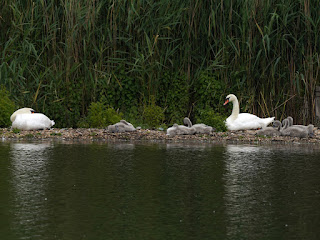A young Jay in the Flower Walk begged a parent to feed it, but there wasn't anything on offer.
It perched on a branch and was clearly grown up enough to know that I had some peanuts, so I threw one into the flower bed for it.
It flew away so I didn't see whether it could cope with shelling the peanut. Young Carrion Crows take a while to learn how to do it.
Other young birds included a Long-Tailed Tit in a holly tree near Peter Pan ...
... and another in the Dell.
Two more pictures from Ahmet Amerikali: a Dunnock near the Henry Moore sculpture carrying insects for its chicks ...
... and a Wren clinging to the low railings near the Diana fountain.
The male Little Owl at the Round Pond was in his usual lime tree. He gave me a triumphant look because I couldn't find an owlet. One was calling from a horse chestnut and I could hear exactly where it was, but it was so well hidden in the leaves that I couldn't see as much as a feather from any angle.
Most of the gulls that have been trying to copy Pigeon Eater's success have been Lesser Black-Backed Gulls like him. But a Herring Gull has now joined in, and here it was starting to eat a pigeon it had certainly killed. A Lesser Black-Back lurked enviously but wasn't getting any.
A Great Crested Grebe chick waited for its parent to bring a fish, saw it in the distance, called and hurried over, but the parent hadn't caught anything and dived again so the chick went back to waiting. The supply of small fish on the Serpentine seems poor this year, and this chick is the only survivor of the original brood.
The grebes that were hanging around last year's nest site under the willow by the bridge have now started nesting. The nest can only be seen from across the lake.
A Coot and five teenage chicks rested on a bag of straw in a fountain pool in the Italian Garden and passed the time by preening. (Regular readers will know that the straw was put in as a futile attempt to check the growth of algae, a traditional remedy that never works.)
The Egyptian Goose with small goslings near the boat hire platform was sheltering them under her wings, so there was no chance to see how many had survived.
There was a large mob of Egyptians on the opposite shore.
When Egyptians first settled in the park about 25 years ago they took no notice at all of the northern seasons, breeding and moulting at odd times of year. Some of them still do, but now that they are numerous most of them seem to be settling into the same pattern as the big geese, flying into the Serpentine to moult in June.
The pair of Mandarins on the Long Water have got into the habit of resting at the south end of the gravel bank ...
... as far as possible from the dangerous Mute Swan family at the other end.
Bees generally stick to one kind of flower when gathering pollen, but this Common Carder at the back of the Lido started on bird's-foot trefoil ...
... found it disappointing, and switched to red clover. Both plants belong to the same family but the flowers are different in shape and each requires its own technique.




%202024%201a.jpg)
%202024%201a.jpg)








Hi Ralph, what ALOT of Egyptians....has there been any incidence of "angel wing" in the park this year ? A horrible condition...(Is it a lack of calcium in the diet?).probably people feeding them white bread....I never ceace to be amazed by your insect pics.. BTW the "S" setting on my sony DSLR has made a big difference...tried it on some flying gulls last night....regards,Stephen....
ReplyDeleteThree of the five Egyptian goslings from Marble Arch have angel wing. So did the single eldest gosling at the Lido, now dead and probably got by a fox. It's a hereditary defect. London Egyptians are pretty inbred.
ReplyDeleteGlad the S setting is useful. I use it almost exclusively, leaving the camera to choose aperture and ISO which it does well enough.
How sad that such a high proportion of the goslings have this awful condition...thanks yet again for the book advice (which I am reading very keenly !) and the DSLR advice, regards, Stephen..
ReplyDeleteMaybe the Little Owl is playing a game with you, his old and trusty friend. "See if you can find my owlet!". I guess even Little Owls will need friendly company to fight boredom.
ReplyDeleteTinúviel
i don't think that owl sees me as company. More as a daily mild nuisance, tolerable now after several years.
Delete